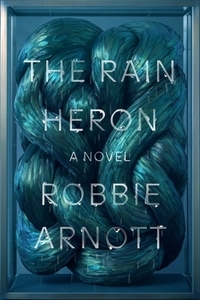The Rain Heron by Robbie Arnott
 Wednesday, February 10, 2021 at 6:07AM
Wednesday, February 10, 2021 at 6:07AM 
Published in Australia in 2020; published by Farrar, Straus and Giroux (FSG Originals) on February 9, 2021
A central character in The Rain Heron believes she brought a myth to life and comes to regret her actions. Robbie Arnott creates a myth and brings a novel to life as he tells the story of two women whose lives the myth changes.
The Rain Heron opens with a fable about a heron that brings prosperity to an unlucky farmer until a jealous neighbor kills it and brings misfortune to everyone. The heron is nearly transparent, a bird made of water. Later in the story, we learn that the rain heron (or perhaps a different one) actually exists and that it is capable of changing the climate in its immediate vicinity by breathing steam or frost.
The main story takes place in an unnamed country in troubled times. The country has experienced a coup. The weather is extreme and unpredictable. Jobs have disappeared. Schools are closed and crime is rampant.
When the main story starts, we know only that a woman named Ren is living on her own on a mountain, using a cave for shelter, trapping animals and foraging for mushrooms. She meets weekly with a man named Barlow, who trades goods from the village for her animal skins. Barlow warns her that soldiers have come to the village but we don’t know why. Ren shows no interest in news of the soldiers until she meets one, a female lieutenant named Zoe Harker who wants her help searching for the mythical heron. Her methods to gain Ren’s assistance are cruel but effective. Harker pays a price for disturbing the heron, just as Ren pays a price for resisting Harker.
The novel’s second part tells Harker’s backstory, although most of that story concerns Harker’s mother, who uses her blood to coax squid into releasing their ink, and the foreigner who tries to learn her secret. The squid, like the rain heron, have mythological qualities that become apparent during the ink-releasing ritual.
The third part returns to the present, focusing largely on a medic named Daniel as Harker’s soldiers turn to the next phase of their mission. When Daniel asks Harker why the generals want the rain heron, she responds, “Men want things. They hear about something and pretty soon they’re convinced it belongs to them.” Harker's jaded view of men may change before the novel ends.
Harker’s story, in fact, is one of a constantly changing life, a life of apparent self-discovery followed by her discovery that she cannot abide the person she has become. Daniel’s story is a struggle to retain the sense of hope and empathy that has sustained his young life in the face of the horrors he has seen.
In the novel’s concluding part, a worker at a wildlife sanctuary tells Harker that he believed in rain herons as a child, because children believe everything that they are told, but later stopped believing in impossible things. After the coup, when things stopped making sense, he found it possible to believe in the impossible again. The worker, Alec, was a terrible soldier who was finally assigned to the sanctuary as a research assistant. Now he’s alone and forgotten, a condition that suits him. It seems a good place for Harker to join him in a brooding reflection on the lessons we might learn from myths. At least until the past catches up with the present, leading to a final dramatic moment that will change Harker’s life again.
Arnott balances a harsh story with soothing prose that carries the plot in the grip of its steady currents. His characters are decent people who live in indecent times, people who might behave indecently without losing their humanity. The novel’s ending combines the myth of the rain heron with the myth of the squid to make something new and wondrous.
If myths teach lessons, one lesson taught by The Rain Heron is that reality does its best to crush mythology, yet we can learn from both. We can learn from our mistakes. We can crawl up from the depths of our despair. And if we can’t change the past, we can at least make amends.
Myths are meant to tell us something about where we came from and who we are. They help us see ourselves with sharper clarity. By blending the motifs of mythology with the dangers that confront inhabitants of the modern world (unstable government, global warming), The Rain Heron reminds us that we can be better than we have been, that we possess the power to transform ourselves and our world, to make the impossible possible.
RECOMMENDED
Reader Comments